THE STUDY OF AMINO ACID COMPOSITION OF ARTEMISIA BALCHANORUM KRASCH AND ARTEMISIA TAURICA WILLD HERB
DOI:
https://doi.org/10.14739/2409-2932.2014.1.24511Keywords:
Artemisia balchanorum Krasch., Artemisia taurica Willd., aminoacids, high-performance liquidchromatographyAbstract
In our research we studied wormwoods (Artemisia) - the large genus of the aster family (Asteraceae) that includes more than 400 species. On theterritoryofUkrainethere are growing more than 23 of its species. The objects of the study were lemon tarragon (A. balchanorum Krasch.) and Tauride sagebrush (A. taurica Willd.) which grow inCrimea.
The aim of research was to study the qualitative and quantitative amino acid content in lemon tarragon and Tauride sagebrush. Plant material was harvested inSimferopolandCrimearegions of Belogosk during budding (July-September 2012). The content and concentration of amino acids were revealed by metod of high effective liquid chromatography on the AAA T-339 (CzechRepublic).
As the result of research we have determined that the amount content of amino acids in the herbs of Artemisia balchanorum Krasch. and Artemisia taurica Willd was different. Thus, the total content of both essential and non-essential (free and bound) amino acids is higher in the Artemisia taurica Willd then in the Artemisia balchanorum Krasch. (8,51 ± 0,40% vs 8,17 ± 0,39%). Comparison of concentrations of specific amino acids shows that in the vast majority of their content is also higher in the lemon sagebrush herb. These results are the basis for a more thorough study of investigated species as sources of natural bioactive substances.
Key words: Artemisia balchanorum Krasch., Artemisia taurica Willd., amino acids, highly effective liquid chromatography.
References
Волочай В.І. Вивчення амінокислотного складу трави Галінсоги дрібноквіткової та Галінсоги війчастої / В.І. Волочай, В.М. Ковальов // Запорожский медицинский журнал. – 2012. – № 3(72). – С. 44–46.
Воробьева Н.В. Цветной атлас растений Крыма. Книга вторая / Н.В. Воробьева. – Симферополь : Бизнес-Информ, 2012. – 336 с.
Гараева С.Н. Аминокислоты в живом организме / С.Н. Гараева, Г.В. Редкозубова, Г.В. Посталати. – Кишинев : Акад. наук Молдовы, Ин-т физиологии и санокреалогии, 2009. – 552 с.
Новые сорта ароматических и лекарственных растений селекции Никитского ботанического сада / [В.Д. Работягов, Л.А. Хлыпенко, Л.В. Свиденко и др.] // Труды Никитского ботанического сада. – 2011. – Т. 133. – С. 5–17.
Поляков П.П. Род Полынь – Artemisia L. // Флора СССР. – М. ; Л., АН СССР, 1961. – Т. 26. – С. 125–630.
Растения Крыма: коварные друзья / [под общ. ред. академика В.Н. Ежова]. – Ялта, 2010. – 216 с.
Хелдт Г.В. Биохимия растений / Г.В. Хелдт ; [под редакцией А.М. Носова и В.В. Чуба]. – М. : БИНОМ, 2011. – 471 с.
Эфирномасличные и пряно-ароматические растения / [О.К. Либусь, В.Д. Работягов, С.П. Кутько, Л.А. Хлыпенко]. – Херсон : Айлант, 2004. – 272 с.
Downloads
How to Cite
Issue
Section
License
Authors who publish with this journal agree to the following terms:
- Authors retain copyright and grant the journal right of first publication with the work simultaneously licensed under a Creative Commons Attribution License that allows others to share the work with an acknowledgement of the work's authorship and initial publication in this journal.

- Authors are able to enter into separate, additional contractual arrangements for the non-exclusive distribution of the journal's published version of the work (e.g., post it to an institutional repository or publish it in a book), with an acknowledgement of its initial publication in this journal.
- Authors are permitted and encouraged to post their work online (e.g., in institutional repositories or on their website) prior to and during the submission process, as it can lead to productive exchanges, as well as earlier and greater citation of published work (See The Effect of Open Access)

